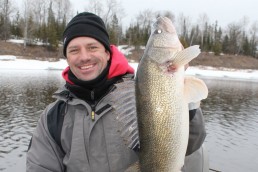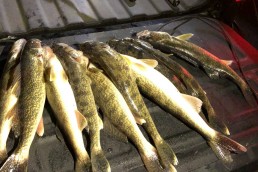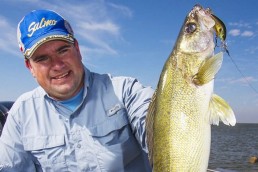Moving Water: Your Best Bet for Early-season Walleyes
SHARE THIS POST
Spring is always welcomed from those who live in the Upper Midwest, especially after a brutal winter with excess snow, frigid temperatures or both. There just seems to reach a time where we are more than ready for a change.
For anglers, what we can do this time of the year is really dependent on the weather. If the cold hangs on, then the ice is surely going to stick around. Head north, and you will be sure to find fishable lakes for your late ice panfish bite. But if Mother Nature has different ideas and spring comes early, then the ice fishing gear will get put away.
Weather can and does play a major roll in what you will be able to do, but if you want a sure thing for this transitional time, head to the moving water. Rivers will always open the earliest, giving anglers the opportunity to dig out the open-water gear once again. Not only that, but it is also the time that walleyes and gamefish swim upstream in order to spawn. It’s a recipe that usually turns out well, especially on a sunny, early spring day.
Now is when you can feel like a pro, because the fish are pretty predictable. The formula is simple: Be there and get down to the bottom. You really don’t have to worry whether you should use crankbaits, leeches or ‘crawlers. A jig and minnow is the go-to lure of choice here and there is no reason to doubt it. Depending on the depth and the current, use an appropriate-sized jig to allow you to get close to the bottom. A pro’s tip is to use a shorter shank jig such as the Northland Fireball jig. This keeps the minnow tight to the jig, creating a tighter package that works wonders in rivers. Occasionally lower your rod tip to ensure that you are in the fish’s strike zone.
Line size should be a little more than what you would use on a lake, but not by much. Superlines are great for feeling the bottom and bites, but not so fun as when you get snagged, as it can be a chore to get it free. Tying on a 4-foot leader of 7-pound Sufix fluorocarbon will give you the best of both worlds. If you want to keep it simple, then stick with a 7- to 8-pound-test monofilament such as Sufix Elite.
Now that you have the lure choice pegged, there are a few methods to fish. Using the current, you can simply drift downstream hoping to encounter a fish or two. Do it enough, and you or someone else in the boat will make contact. Back-trolling upstream will allow you to keep your bait in front of the fish a little longer, and more times than not, will produce a few more bites. As you travel, cross back and forth too, trying to dial in a hot school.
Are you enjoying this post?
You can be among the first to get the latest info on where to go, what to use and how to use it!
One of the simplest, most effective methods is to anchor and fan-cast. Sometimes it is hard to keep casting at the same thing over and over again, but as the fish are moving up you will get more opportunities to present it in front of fish. Don’t just randomly drop anchor and start casting; look for a pool, rock pile, point, sandbar, rapids, feeder creek or some other structure that will break up the river’s flow. Fish will look for areas that have slack current so they can rest and also ambush prey. By anchoring upstream of these locations, you can easily cast to them and pinpoint some hot zones. Keep in mind that you just want to slowly swim the jig back to the boat. Occasionally try to touch the bottom, but be careful not to snag the bottom.
If the water clarity is a little less than ideal, it helps to add a bright twister tail to the jig and then add a minnow. Twister tails, like the Impulse Swim’N Grub, are also impregnated with sauce to keep a fish holding on. Sometimes you don’t even have to add the minnow, but it usually does improve the odds. When using grubs, you will want to use a longer shank jig such as a Sink’N Jig to allow the twister tail to look normal.
Make sure you check the fishing regulations on your destination and be safe. Wear your life jacket and be sure to have company with you.
Early-season trips on rivers are good for an angler’s soul. And keep it simple and keep your line wet. Make it a point to do so this year, you won’t regret it.
MWO
SHARE THIS POST
Did you enjoy this post?
You can be among the first to get the latest info on where to go, what to use and how to use it!
Steve Mattson
Steve Mattson has been writing articles for MidWest Outdoors since 2001. He is a driven angler, guide and sponsored tournament pro who has won both bass and panfish tournaments, and has placed in walleye and pike events. He resides in northern Minnesota and enjoys helping others catch more fish. For more info: mattsonangling.com and @mattsonangling.



